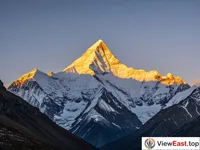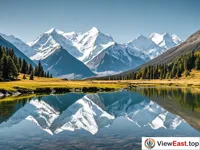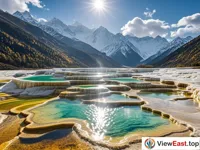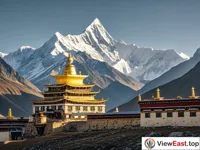







A. Scenic Spot Introduction
Mount Gongga: The Natural Sanctuary of the King of Shu Mountains
Nestled in the western part of China, within the Ganzi Tibetan Autonomous Prefecture of Sichuan Province, stands Mount Gongga, known as the "King of Shu Mountains." It is the main peak of the Hengduan Mountains and the tallest mountain in Sichuan Province. This region is not only a paradise for mountaineers and nature enthusiasts but also a treasure trove for studying Tibetan culture and history.
Natural Landscape: The Splendor of the Frozen Throne
The natural landscape of Mount Gongga is breathtaking. The summit is perennially snow-capped with glaciers, while the foothills boast lush grasslands and clear streams. In spring, the mountains are adorned with blooming wildflowers; in summer, the meadows are a vibrant green; in autumn, the forests are painted with colors; in winter, the snow-capped mountains stand majestic. The changing scenery through the seasons is like a palette of nature, presenting a series of captivating scenes.
Historical Culture: The Heritage of Tibetan Culture
The area around Mount Gongga is one of the birthplaces of Tibetan culture, with a long history and rich cultural heritage. The local Tibetan people maintain their traditional nomadic lifestyle, passing down ancient legends and beliefs. Here, visitors can experience authentic Tibetan culture and feel their reverence for nature and love for life.
Cultural Features: Harmonious Coexistence with Nature
The Tibetan people of Mount Gongga live in harmony with nature, and their lifestyle and cultural traditions reflect respect and protection for the environment. In this place, one can sense the beauty of the harmonious relationship between humans and nature, experiencing the tranquility and purity far from the hustle and bustle of cities.
Unique Experience: Mountaineering Adventure, Immersion in Tibetan Culture
Visitors to Mount Gongga can attempt mountaineering adventures, challenging themselves and feeling the thrill of conquering peaks. Additionally, they can visit local Tibetan villages to learn about their way of life, taste Tibetan cuisine, and participate in Tibetan festivals, experiencing the unique charm of Tibetan culture.
Metaphor: Mount Gongga, the Crown Jewel of Nature
Mount Gongga is like a dazzling gem on the crown of nature, with its magnificent natural scenery and profound cultural heritage. It is a wonder of nature and a cultural treasure.
B. Travel Suggestions
Transportation Routes: From Around the World to Mount Gongga
Tourists can fly into Chengdu Shuangliu International Airport and then take a long-distance bus or rent a car to Mount Gongga. The drive from Chengdu to Mount Gongga takes about 10-12 hours, passing through many scenic spots.
Tourism Convenience: Well-Developed Tourism Facilities
Although remote, the area around Mount Gongga has relatively well-developed tourism facilities. There are dedicated visitor centers providing consultation services, and guided services to help tourists plan their itinerary. In addition, there are environmentally friendly sightseeing buses to facilitate travel between different attractions.
Food and Accommodation: Sampling Tibetan Cuisine
There are various hotels and guesthouses around Mount Gongga offering accommodation services. Visitors can taste authentic Tibetan cuisine, such as tsampa, butter tea, and highland barley wine.
Safety: A Secure Tourism Environment
The area around Mount Gongga has a good public safety record, ensuring a worry-free visit for tourists. The local government and community place great emphasis on tourism safety to ensure the personal and property safety of visitors.